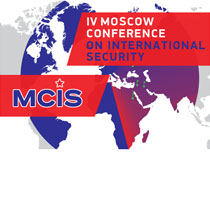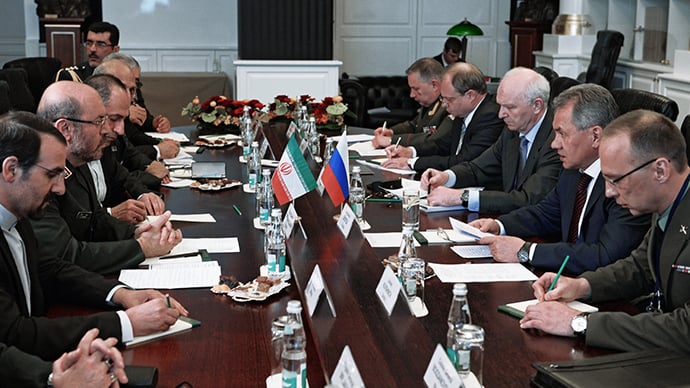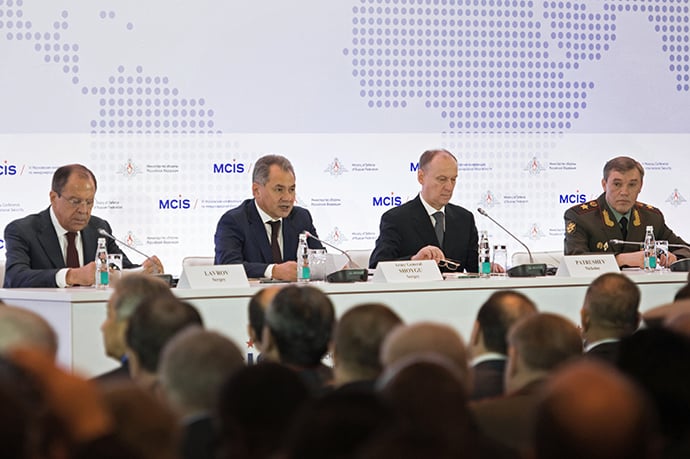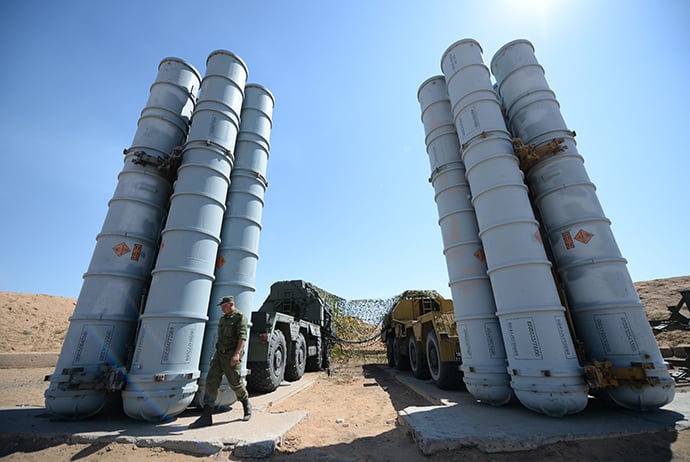Did a Chinese-Russian-Iranian Coalition opposing NATO Debut in Moscow?

The Moscow Conference on International Security in April was used as a venue to give notice to the US and NATO that other world powers will not let them do as they please.
Talk about joint efforts between China, India, Russia and Iran against NATO expansion was augmented with plans for tripartite military talks between Beijing, Moscow, and Tehran.
Defense ministers and military officials from all over the world gathered on April 16 at the landmark Radisson Royal or Hotel Ukraina, one of the best pieces of Soviet architecture in Moscow, which is known as one of the “Seven Sisters” that were constructed during Joseph Stalin’s time. The two-day event hosted by the Russian Defense Ministry was the fourth annual Moscow Conference on International Security (MCIS).
Russia’s Defense Minister Shoigu and Iran’s Defense Minister Dehghan at the IV Moscow Conference on International Security (RIA Novosti/Iliya Pitalev)
Civilian and military officials from over seventy countries, including NATO members, attended. Fifteen defense ministers took part in the event. However, aside from Greece, defense ministers of NATO countries did not participate in the conference.
Unlike previous years, the MCIS organizers did not send Ukraine an invitation for 2015’s confab. According to Russian Deputy Defense Minister Anatoly Antonov, “At this stage of the brutal information antagonism in regard to the crisis in southeastern Ukraine, we decided not to inflame the situation at the conference and at this stage made the decision not to invite our Ukrainian colleagues to the event.”
On a personal note, as a matter of interest I have followed these types of conferences for years, because important statements about foreign and security policies tend to come out of them. This year I was keen for the inauguration of this particular security conference. Aside from it taking place at a time where the geopolitical landscape of the globe is rapidly shifting, I was interested to see what the conference would produce since I was asked in 2014 through the Russian Embassy in Canada if I was interested in attending the IV MCIS.
The rest of the world speaks: Hearing non-Euro-Atlantic security concerns
The Moscow conference is the Russian equivalent to the Munich Security Conference held at the Hotel Bayerischer Hof in Germany. There, however, are critical differences between the two events.
While the Munich Security Conference is established around Euro-Atlantic security and views global security from the ‘Atlanticist’ standpoint of NATO, the MCIS represents a much broader and diverse global perspective. It represents the rest of the non-Euro-Atlantic world’s security concerns, particularly the Middle East and Asia-Pacific. Ranging from Argentina, India, and Vietnam to Egypt and South Africa, the conference at the Hotel Ukraina brought a variety of big and small players to the table whose voices and security interests, in one way or another, are otherwise undermined and ignored in Munich by US and NATO leaders.
Russian Defense Minister Sergey Shoigu, who holds the rank of a flag officer that is equal to that of a four-star general in most NATO countries, opened the conference. Also speaking and seated next to Shoigu were Russian Foreign Minister Sergey Lavrov and other high-ranking officials. All of them addressed Washington’s multispectral warfare that has utilized color revolutions, like EuroMaidan in Ukraine and the Rose Revolution in Georgia, for regime change. Shoigu cited Venezuela and China’s Hong Kong Special Administrative Region as failed color revolutions.
Foreign Minister Lavrov reminded the attendees that the possibilities of a dangerous world conflict were increasing due to the lack of concern by the US and NATO for the security of others and a lack of constructive dialogue. When making his argument, Lavrov cited US President Franklin Roosevelt by saying, “There can be no middle ground here. We shall have to take the responsibility for world collaboration, or we shall have to bear the responsibility for another world conflict.” “I believe that they formulated one of the main lessons of the most devastating global conflict in history: it is only possible to meet common challenges and preserve the peace through collective, joint efforts based on respect for the legitimate interests of all partners,” he explained about what world leaders learned from the Second World War.
Shoigu had over ten bilateral meetings with the different defense ministers and chiefs who arrived in Moscow for the MCIS. During a meeting with the Serbian Defense Minister Bratislav Gasic, Shoigu said that Moscow considers Belgrade a reliable partner in military cooperation.
From left to right: Foreign Minister Sergey Lavrov, Defense Minister Sergey Shoigu, Security Council Secretary Nikolai Patrushev, and Chief of the General Staff Valery Gerasimov opening the MCIS (RIA Novosti/Iliya Pitalev)
Chinese-Russian-Iranian coalition: Washington’s nightmare
The myth that Russia is internationally isolated was shot down again during the conference, which has also resulted in some important announcements.
Kazakhstani Defense Minister Imangali Tasmagambetov and Shoigu announced that the implementation for a joint Kazakhstani-Russian air defense system had begun. This is not only indicative of the integration of the air space of the Collective Security Treaty Organization, but part of a trend. It heralded other announcements against NATO’s missile defense shield.
The most vigorous statement though was that of Iranian Defense Minister Hussein Dehghan. Brigadier-General Deghan said that Iran wanted China, India, and Russia to stand together in jointly opposing the eastward expansion of NATO and the threat posed by the alliance’s missile shield project to their collective security.
During a meeting with Chinese Defense Minister Chang Wanquan, Shoigu emphasized that Moscow’s military ties with Beijing are its “overriding priority.” In another bilateral meeting the defense honchos of Iran and Russia confirmed that their cooperation will be part of the cornerstones of a new multipolar order and that Moscow and Tehran were in harmony in their strategic approach to the US.
After Dehghan and the Iranian delegation met with Shoigu and their Russian counterparts, it was announced that a tripartite summit may take place between Beijing, Moscow, and Tehran. The idea was later endorsed by the Chinese delegation.
The geopolitical environment is changing and it is not sympathetic to US interests. Not only has a Eurasian Economic Union been formed by Armenia, Belarus, Kazakhstan, and Russia in the post-Soviet heart of Eurasia, but Beijing, Moscow, and Tehran — the Eurasian Triple Entente — have been in a long process of coming together politically, strategically, economically, diplomatically, and militarily.
Eurasian harmony and integration challenges the US position in its “Western perch” and bridgehead in Europe and even orients US allies to act more independently. This is one of the central themes explored by my book The Globalization of NATO.
Former US security bigwig Zbigniew Brzezinski warned US elites against the formation of a Eurasian “coalition that could eventually seek to challenge America’s primacy.” According to Brzezinski such a Eurasian alliance would arise as a “Chinese-Russian-Iranian coalition” with Beijing as its focal point.
“For Chinese strategists, confronting the trilateral coalition of America and Europe and Japan, the most effective geopolitical counter might well be to try and fashion a triple alliance of its own, linking China with Iran in the Persian Gulf/Middle East region and with Russia in the area of the former Soviet Union,” Brzezinski warns.
“In assessing China’s future options, one has to consider also the possibility that an economically successful and politically self-confident China — but one which feels excluded from the global system and which decides to become both the advocate and the leader of the deprived states of the world — may decide to pose not only an articulate doctrinal but also a powerful geopolitical challenge to the dominant trilateral world,” he explains.
More or less, this is the track that the Chinese are following. Minister Wanquan flatly told the MCIS that a fair world order was needed.
The threat for the US is that a Chinese-Russian-Iranian coalition could, in Brzezinski’s own words, “be a potent magnet for other states dissatisfied with the status quo.”
A Russian soldier during an exercise involving the S-300 surface-to-air missile systems in Astrakhan Region (RIA Novosti/Pavel Lisitsyn)
Countering the US and NATO missile shield in Eurasia
A new “Iron Curtain” is being erected by Washington around China, Iran, Russia, and their allies through the US and NATO missile infrastructure. This missile network is offensive and not defensive in intent and motivation.
The Pentagon’s goal is to neutralize any defensive responses from Russia and other Eurasian powers to a US ballistic missile attack, which could include a nuclear first strike. Washington does not want to allow Russia or others to have a second strike capability or, in other words, have the ability to respond to an attack by the Pentagon.
In 2011, it was reported that Russian Deputy Prime Minister Dmitry Rogozin, who was Moscow’s envoy to NATO at the time, would be visiting Tehran to speak about the NATO missile shield project. Various reports were published, including by the Tehran Times, claiming that the governments of Russia, Iran, and China were planning on creating a joint missile shield to counter the US and NATO. Rogozin, however, refuted the reports. He said that missile defense was discussed between the Kremlin and its military allies in the Collective Security Treaty Organization (CSTO).
The idea of defense cooperation between China, Iran, and Russia against the NATO missile shield remained afloat since 2011. Since then Iran has moved closer to becoming an observer in the CSTO, like Afghanistan and Serbia. Beijing, Moscow, and Tehran have all moved closer together too due to issues like Syria, EuroMaidan, and the Pentagon’s “Pivot to Asia.” Deghan’s calls for a collective approach by China, India, Iran, and Russia against the missile shield and NATO expansion coupled with the announcements at the MCIS about tripartite military talks between China, Iran, and Russia point in this direction too.
Russia’s S-300 and S-400 air defense systems are being rolled out across Eurasia from Armenia and Belarus to Kamchatka as part of a state-of-the-art countermove to the new “Iron Curtain.” These air defense systems make Washington’s objectives to neutralize the possibility of a reaction or second strike much harder.
Even NATO officials and the Pentagon, which referred to the S-300 as the SA-20 system, admit this. “We have studied it and trained to counter it for years. While we are not scared of it, we respect the S-300 for what it is: a very mobile, accurate, and lethal missile system,” US Air Force Colonel Clint Hinote has written for the Washington-based Council on Foreign Relations.
Although it has been speculated that the sale of the S-300 systems to Iran mark the start of an international arms sales bonanza in Tehran as a result of the Lausanne talks and that Moscow is trying to have a competitive edge in a reopening Iranian market, in reality the situation and motivations are much different. Even if Tehran buys different quantities of military hardware from Russia and other foreign sources, it has a policy of military self-sufficiency and primarily manufactures its own weapons. A whole series of military hardware — ranging from tanks, missiles, combat jets, radar detectors, rifles, and drones to helicopters, torpedoes, mortar shells, warships, and submarines — are made domestically inside Iran. The Iranian military even contends that their Bavar-373 air defense system is more or less the equivalent of the S-300.
Moscow’s delivery of the S-300 package to Tehran is more than just about unpretentious business. It is meant to cement Russo-Iranian military cooperation and to enhance Eurasian cooperation against Washington’s encircling missile shield. It is one step closer to the creation of a Eurasian air defense network against the missile threat posed by the US and NATO against nations that dare not bend the knee to Washington.
This article was originally published by RT on April 23, 2015. Please click here for a Russian-language synopsis by RIA Novosti.




